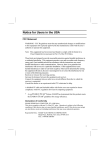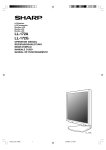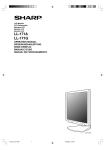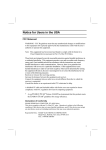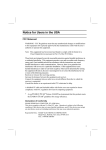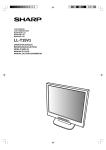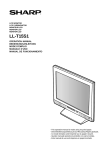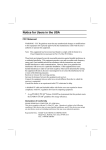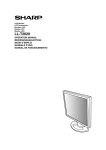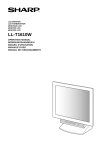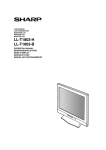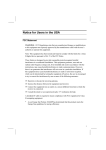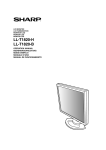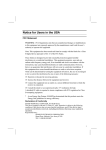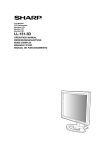Download Sharp LL-171A Car Video System User Manual
Transcript
LCD Monitor LCD Farbmonitor Moniteur LCD Monitor LCD Monitor LCD LL-171A LL-171G OPERATION MANUAL BEDIENUNGSANLEITUNG MODE D'EMPLOI MANUALE D'USO MANUAL DE FUNCIONAMIENTO LL-171A 171AG_cover1-2.P65 1 12/4/2003, 1:12 PM WARNING – FCC Regulations state that any unauthorized changes or modifications to this equipment not expressly approved by the manufacturer could void the user's authority to operate this equipment. Note: This equipment has been tested and found to comply with the limits for a Class B digital device pursuant to Part 15 of the FCC Rules. These limits are designed to provide reasonable protection against harmful interference in a residential installation. This equipment generates, uses and can radiate radio frequency energy and, if not installed and used in accordance with the instructions, may cause harmful interference to radio communications. However, there is no guarantee that interference will not occur in a particular installation. If this equipment does cause harmful interference to radio or television reception, which can be determined by turning the equipment off and on, the user is encouraged to try to correct the interference by one or more of the following measures: - Reorient or relocate the receiving antenna. - Increase the distance between the equipment and receiver. - Connect the equipment into an outlet on a circuit different from that to which the receiver is connected. - Consult the dealer or an experienced radio/TV technician for help. English Use nothing but the included cables and AC cord to insure compliance with FCC regulation for Class B computing equipment. Declaration of Conformity SHARP LCD Color Monitor LL-171A-W/LL-171A-B/LL-171G-W/LL-171G-B This device complies with part 15 of the FCC rules. Operation is subject to the following conditions: (1) this device may not cause harmful interference, and (2) this device must accept any interference received, including interference that may cause undesired operation. Responsible Party: SHARP ELECTRONICS CORPORATION Sharp Plaza, Mahwah, New Jersey 07430 TEL: 1-800-BE-SHARP * As an ENERGY STAR® Partner, SHARP has determined that this product meets the STAR® guidelines for energy efficiency. ENERGY This product utilizes tin-lead solder, and fluorescent lamp containing a small amount of mercury. Disposal of these materials may be regulated due to environmental considerations. For disposal or recycling information, please contact your local authorities or the Electronics Industries Alliance: www.eiae.org 3 171AG_notice.P65 3 Deutsch FCC Statement Français Serial No.: Italiano Model No.: Español IMPORTANT: To aid in reporting in case of loss or theft, please record the monitor's model and serial numbers in the space provided. The numbers are located on the rear of the monitor. English Notice for Users in the USA 12/4/2003, 1:14 PM Notice for Users in Europe This equipment complies with the requirements of Directives 89/336/EEC and 73/23/EEC as amended by 93/68/EEC. Dieses Gerät entspricht den Anforderungen der EG-Richtlinien 89/336/EWG und 73/23/EWG mit Änderung 93/68/EWG. Ce matériel répond aux exigences contenues dans les directives 89/336/CEE et 73/23/CEE modifiées par la directive 93/68/CEE. Dit apparaat voldoet aan de eisen van de richtlijnen 89/336/EEG en 73/23/EEG, gewijzigd door 93/68/ EEG. Dette udstyr overholder kravene i direktiv nr. 89/336/EEC og 73/23/EEC med tillæg nr. 93/68/EEC. Quest' apparecchio è conforme ai requisiti delle direttive 89/336/EEC e 73/23/EEC, come emendata dalla direttiva 93/68/EEC. Η εγκατασταση ανταποκρινεται στιζ απαιτησειζ των οδηγιων τηζ Ευρωπαïκηζ Ενωσηζ 89/336/ΕΟΚ κατ 73/23/ΕΟΚ, óπωζ οι κανονισµοι αυτοι συµπληρωθηκαν απó την οδηγια 93/68/ΕΟΚ. Este equipamento obedece às exigências das directivas 89/336/CEE e 73/23/CEE, na sua versão corrigida pela directiva 93/68/CEE. Este aparato satisface las exigencias de las Directivas 89/336/CEE y 73/23/CEE, modificadas por medio de la 93/68/CEE. Denna utrustning uppfyller kraven enligt riktlinjerna 89/336/EEC och 73/23/EEC så som komplette ras av 93/68/EEC. Dette produktet oppfyller betingelsene i direktivene 89/336/EEC og 73/23/EEC i endringen 93/68/EEC. Tämä laite täyttää direktiivien 89/336/EEC ja 73/23/EEC vaatimukset, joita on muutettu direktiivillä 93/ 68/EEC. CAUTION: TO PREVENT ELECTRICAL SHOCK, DISCONNECT THE AC CORD BEFORE SERVICING. CAUTION: FOR A COMPLETE ELECTRICAL DISCONNECTION, PULL OUT THE MAIN PLUG. VORSICHT: UM DIE STROMZUFUHR VOLLSTÄNDIG ZU UNTERBRECHEN, DEN NETZSTECKER HERAUSZIEHEN ENTFERNEN. ATTENTION : POUR UN ARRET TOTAL DE L'APPAREIL, DEBRANCHEZ LA PRISE DU COURANT SECTEUR. VARNING: FÖR TOTAL ELEKTRISK URKOPPLING, KOPPLA UR KONTAKTEN OCH. PRECAUCION: PARA UNA COMPLETA DESCONEXION ELECTRICA DESENCHUFE LA CLAVIJA DE LA RED. PRECAUCION: A FIN DE EVITAR DESCARGAS ELÉCTRICAS, DESCONECTE EL ENCHUFE DE LA RED ANTES DE REALIZAR CUALQUIER OPERACIÓN DE SERVICIO. ATTENZIONE: PER EVITARE FOLGORAZIONI, SCOLLEGATE IL CAVO DI COLLEGAMENTO ALLA RETE IN ALTERNATA PRIMA DI EFFETTUARE UN INTERVENTO DI SERVIZIO TECNICO. ATTENZIONE: PER UNO SCOLLEGAMENTO ELETTRICO COMPLETO, TIRATE FUORI LA SPINA PRINCIPALE. 4 171AG_notice.P65 4 12/4/2003, 1:14 PM Deutsch Français Español Italiano FOR CUSTOMERS IN U.K. IMPORTANT The wires in this mains lead are coloured in accordance with the following code: GREEN-AND-YELLOW : Earth BLUE : Neutral BROWN : Live As the colours of the wires in the mains lead of this apparatus may not correspond with the coloured markings identifying the terminals in your plug proceed as follows: • The wire which is coloured GREEN-AND-YELLOW must be connected to the terminal in the plug which is marked by the letter E or by the safety earth or coloured green or green-and-yellow. • The wire which is coloured BLUE must be connected to the terminal which is marked with the letter N or coloured black. • The wire which is coloured BROWN must be connected to the terminal which is marked with the letter L or coloured red. Ensure that your equipment is connected correctly. If you are in any doubt consult a qualified electrician. "WARNING: THIS APPARATUS MUST BE EARTHED." English Notice for Users in the UK English Notice for Users in Australia Service Inquiries Please contact your dealer for service if required or contact Sharp Corporation of Australia on 1 300 13 50 22 for referral to your nearest Sharp authorized Service Center. 5 171AG_notice.P65 5 12/4/2003, 1:14 PM TCO Development SE-114 94 Stockholm, Sweden Fax: +46 8 782 92 07 Email (Internet): [email protected] Current information regarding TCO'99 approved and labelled products may also be obtained via the Internet, using the address: http://www.tco-info.com/ Environmental requirements Congratulations! You have just purchased a TCO'99 approved and labelled product! Your choice has provided you with a product developed for professional use. Your purchase has also contributed to reducing the burden on the environment and also to the further development of environmentally adapted electronics products. Flame retardants Flame retardants are present in printed circuit boards, cables, wires, casings and housings. Their purpose is to prevent, or at least to delay the spread of fire. Up to 30% of the plastic in a computer casing can consist of flame retardant substances. Most flame retardants contain bromine or chloride, and those flame retardants are chemically related to another group of environmental toxins, PCBs. Both the flame retardants containing bromine or chloride and the PCBs are suspected of giving rise to severe health effects, including reproductive damage in fish-eating birds and mammals, due to the bio-accumulative* processes. Flame retardants have been found in human blood and researchers fear that disturbances in foetus development may occur. The relevant TCO'99 demand requires that plastic components weighing more than 25 grams must not contain flame retardants with organically bound bromine or chlorine. Flame retardants are allowed in the printed circuit boards since no substitutes are available. Why do we have environmentally labelled computers? In many countries, environmental labelling has become an established method for encouraging the adaptation of goods and services to the environment. The main problem, as far as computers and other electronics equipment are concerned, is that environmentally harmful substances are used both in the products and during their manufacture. Since it is not so far possible to satisfactorily recycle the majority of electronics equipment, most of these potentially damaging substances sooner or later enter nature. There are also other characteristics of a computer, such as energy consumption levels, that are important from the viewpoints of both the work (internal) and natural (external) environments. Since all methods of electricity generation have a negative effect on the environment (e.g. acidic and climate-influencing emissions, radioactive waste), it is vital to save energy. Electronics equipment in offices is often left running continuously and thereby consumes a lot of energy. Cadmium** Cadmium is present in rechargeable batteries and in the colour-generating layers of certain computer displays. Cadmium damages the nervous system and is toxic in high doses. The relevant TCO'99 requirement states that batteries, the colour-generating layers of display screens and the electrical or electronics components must not contain any cadmium. What does labelling involve? This product meets the requirements for the TCO'99 scheme which provides for international and environmental labelling of personal computers. The labelling scheme was developed as a joint effort by the TCO (The Swedish Confederation of Professional Employees), Svenska Naturskyddsforeningen (The Swedish Society for Nature Conservation) and Statens Energimyndighet (The Swedish National Energy Administration). Approval requirements cover a wide range of issues: environment, ergonomics, usability, emission of electric and magnetic fields, energy consumption and electrical and fire safety. The environmental demands impose restrictions on the presence and use of heavy metals, brominated and chlorinated flame retardants, CFCs (freons) and chlorinated solvents, among other things. The product must be prepared for recycling and the manufacturer is obliged to have an environmental policy which must be adhered to in each country where the company implements its operational policy. The energy requirements include a demand that the computer and/or display, after a certain period of inactivity, shall reduce its power consumption to a lower level in one or more stages. The length of time to reactivate the computer shall be reasonable for the user. Labelled products must meet strict environmental demands, for example, in respect of the reduction of electric and magnetic fields, physical and visual ergonomics and good usability. Below you will find a brief summary of the environmental requirements met by this product. The complete environmental criteria document may be ordered from: Mercury** Mercury is sometimes found in batteries, relays and switches. It damages the nervous system and is toxic in high doses. The relevant TCO'99 requirement states that batteries may not contain any mercury. It also demands that mercury is not present in any of the electrical or electronics components associated with the labelled unit. There is however one exception. Mercury is, for the time being, permitted in the back light system of flat panel monitors as there today is no commercially available alternative. TCO aims on removing this exception when a mercury free alternative is available. CFCs (freons) The relevant TCO'99 requirement states that neither CFCs nor HCFCs may be used during the manufacture and assembly of the product. CFCs (freons) are sometimes used for washing printed circuit boards. CFCs break down ozone and thereby damage the ozone layer in the stratosphere, causing increased reception on earth of ultraviolet light with e.g. increased risks of skin cancer (malignant melanoma) as a consequence. Lead** Lead can be found in picture tubes, display screens, solders and capacitors. Lead damages the nervous system and in higher doses, causes lead poisoning. The relevant TCO'99 requirement permits the inclusion of lead since no replacement has yet been developed. * Bio-accumulative is defined as substances which accumulate within living organisms. ** Lead, Cadmium and Mercury are heavy metals which are Bio-accumulative. 6 171AG_notice.P65 6 12/4/2003, 1:14 PM Deutsch Français Italiano English Español Tips and safety precautions . . . . . . . . . . . . . . . . . . . . . . . . . . . . . . . . . . . . . . . . . . . . . . . . . . . . . . . . . . . . . 8 Product description . . . . . . . . . . . . . . . . . . . . . . . . . . . . . . . . . . . . . . . . . . . . . . . . . . . . . . . . . . . . . . . . . . 10 Angle adjustment, height adjustment . . . . . . . . . . . . . . . . . . . . . . . . . . . . . . . . . . . . . . . . . . . . . . . . . . . . 11 Connecting the monitor and turning the monitor on and off . . . . . . . . . . . . . . . . . . . . . . . . . . . . . . . . . . . 12 Securing the cables [LL-171G] . . . . . . . . . . . . . . . . . . . . . . . . . . . . . . . . . . . . . . . . . . . . . . . . . . . . . . 12 Connecting the monitor to a computer . . . . . . . . . . . . . . . . . . . . . . . . . . . . . . . . . . . . . . . . . . . . . . . . 12 Connection of headphones (commercially available) . . . . . . . . . . . . . . . . . . . . . . . . . . . . . . . . . . . . 15 Connecting the monitor to a power source . . . . . . . . . . . . . . . . . . . . . . . . . . . . . . . . . . . . . . . . . . . . . 15 Turning the power on . . . . . . . . . . . . . . . . . . . . . . . . . . . . . . . . . . . . . . . . . . . . . . . . . . . . . . . . . . . . . . 15 Changing between input terminals [LL-171G] . . . . . . . . . . . . . . . . . . . . . . . . . . . . . . . . . . . . . . . . . . 16 Turning the power off . . . . . . . . . . . . . . . . . . . . . . . . . . . . . . . . . . . . . . . . . . . . . . . . . . . . . . . . . . . . . . 16 Adjusting the screen display and speaker volume . . . . . . . . . . . . . . . . . . . . . . . . . . . . . . . . . . . . . . . . . . 17 Adjusting the backlight . . . . . . . . . . . . . . . . . . . . . . . . . . . . . . . . . . . . . . . . . . . . . . . . . . . . . . . . . . . . . 17 Adjusting the speaker volume . . . . . . . . . . . . . . . . . . . . . . . . . . . . . . . . . . . . . . . . . . . . . . . . . . . . . . . 18 Setting display mode . . . . . . . . . . . . . . . . . . . . . . . . . . . . . . . . . . . . . . . . . . . . . . . . . . . . . . . . . . . . . . 18 Checking product information . . . . . . . . . . . . . . . . . . . . . . . . . . . . . . . . . . . . . . . . . . . . . . . . . . . . . . . 18 Adjusting the screen display . . . . . . . . . . . . . . . . . . . . . . . . . . . . . . . . . . . . . . . . . . . . . . . . . . . . . . . . . . . 19 Automatic screen adjustment (When using an analog signal) . . . . . . . . . . . . . . . . . . . . . . . . . . . . . . 19 Manual screen adjustment . . . . . . . . . . . . . . . . . . . . . . . . . . . . . . . . . . . . . . . . . . . . . . . . . . . . . . . . . . 20 Monitor care . . . . . . . . . . . . . . . . . . . . . . . . . . . . . . . . . . . . . . . . . . . . . . . . . . . . . . . . . . . . . . . . . . . . . . . . 23 Monitor care . . . . . . . . . . . . . . . . . . . . . . . . . . . . . . . . . . . . . . . . . . . . . . . . . . . . . . . . . . . . . . . . . . . . . 23 Storage . . . . . . . . . . . . . . . . . . . . . . . . . . . . . . . . . . . . . . . . . . . . . . . . . . . . . . . . . . . . . . . . . . . . . . . . . 23 Troubleshooting . . . . . . . . . . . . . . . . . . . . . . . . . . . . . . . . . . . . . . . . . . . . . . . . . . . . . . . . . . . . . . . . . . 23 Specifications . . . . . . . . . . . . . . . . . . . . . . . . . . . . . . . . . . . . . . . . . . . . . . . . . . . . . . . . . . . . . . . . . . . . . . . 24 Installing set-up information and the ICC profile (For Windows) . . . . . . . . . . . . . . . . . . . . . . . . . . . . . . . 28 Information about the ColorSync profile (For MacOS) . . . . . . . . . . . . . . . . . . . . . . . . . . . . . . . . . . . . . . . 31 Instructions for attaching a VESA-compliant arm . . . . . . . . . . . . . . . . . . . . . . . . . . . . . . . . . . . . . . . . . . . 32 English Table of Contents 7 171AG_gb.P65 7 12/4/2003, 1:14 PM Tips and safety precautions Location - Do not use the monitor where ventilation is poor, where there is a lot of dust, where humidity is high, or where the monitor may come into contact with oil or steam, as this could lead to fire. - Ensure that the monitor does not come into contact with water or other fluids. Ensure that no objects such as paper clips or pins enter the monitor as this could lead to fire or electric shock. - Do not place the monitor on top of unstable objects or in unsafe places. Do not allow the monitor to come into contact with strong shocks or vibrations. Causing the monitor to fall or topple over may damage it. - Do not use in places where the monitor will be subject to direct sunlight, near heating equipment or anywhere else where there is likelihood of high temperature, as this may lead to generation of excessive heat and outbreak of fire. - The TFT color LCD panel used in this monitor is made with the application of high precision technology. However, there may be minute points on the screen where pixels never light or are permanently lit. Also, if the screen is viewed from an acute angle there may be uneven colors or brightness. Please note that these are not malfunctions but common phenomena of LCDs and will not affect the performance of the monitor. - Do not display a still picture for a long time, as this could cause an afterimage to remain. - If the brightness is adjusted to the minimum setting it may be difficult to see the screen. - The quality of the computer signal may influence the quality of the display. We recommend using a computer able to emit high quality video signals. - Never rub or tap the monitor with hard objects. - Please understand that Sharp Corporation bears no responsibility for errors made during use by the customer or a third party, nor for any other malfunctions or damage to this product arising during use, except where indemnity liability is recognized under law. - This monitor and its accessories may be upgraded without advance notice. The Power Cord - Do not damage the power cord nor place heavy objects on it, stretch it or over bend it. Also, do not add extension cords. Damage to the cord may result in fire or electric shock. - Use only the power cord supplied with the monitor. - Insert the power plug directly into the AC outlet. Adding an extension cord may lead to fire as a result of overheating. - Do not remove or insert the power plug with wet hands. Doing so could result in electric shock. 8 171AG_gb.P65 8 12/4/2003, 1:14 PM Deutsch English Español Notes: - [LL-171A] Use only the cables supplied with the monitor. - Be sure to use cables that are less than 3 m in length. - [LL-171G] The analog signal cable (DVI-I29 pin – mini D-sub15 pin) is to be purchased separately. (model name: NL-C02E) - [LL-171G] The 2-input cable (DVI-I29 pin – DVI-D24 pin/mini D-sub15 pin) is to be purchased separately. (model name: NL-C03J) - You are advised to retain the carton in case the monitor needs to be transported. - Sharp Corporation holds authorship rights to the Utility Disk program. Do not reproduce it without permission. - The shape of the supplied accessories may not be exactly same as shown in this manual. Français Manual Scope - This manual is written for use with the LL-171A and the LL-171G. When describing a different specification between the models, the model name is also given. (If the model name isn't given, the description is true for both models. For product appearance, illustrations of the LL-171A are used in this manual.) - In this manual, Microsoft Windows XP will be referred to as "Windows XP", Microsoft Windows Millennium as "Windows Me", Microsoft Windows 2000 as "Windows 2000", Microsoft Windows 98 as "Windows 98", Microsoft Windows 95 as "Windows 95", and Microsoft Windows Version 3.1 as "Windows 3.1". When there is no need to distinguish between programs, the term "Windows" will be used. - Microsoft and Windows are registered trademarks of Microsoft Corporation. - Macintosh is a registered trademark of Apple Computer, Inc. - All other brand and product names are trademarks or registered trademarks of their respective holders. Italiano Monitor and accessory checklist - Please check that the following items are included in the package. - LCD monitor (1) - Analog signal cable (1) (model name: 0NW1738GAB01A) - [LL-171G] Digital signal cable (1) (model name: 0NW1748LAB007) - Audio cable (1) (model name: 0NW0173056023) - [LL-171G] Cable clamp (2) - CD-ROM (1) - Operation manual (1) English Tips and safety precautions 9 171AG_gb.P65 9 12/4/2003, 6:52 PM Product description [LL-171A] [LL-171G] 15 8 6 15 8 6 7 7 5 5 1 2 3 4 5 5 9 10 11 13 14 1 2 3 4 9 10 1112 13 14 1. AUTO button [LL-171A] ........... This button is used to perform automatic adjustment of the screen (CLOCK, PHASE, H-POS and V-POS). (p.19) INPUT button [LL-171G] ......... To switch between the signal's input terminals. 2. MENU button ........................... This button is used to pop-up, select and close the OSD (On Screen Display) Menu. 3. / MODE button ..................... When the OSD Menu is displayed: This button is used to select menu options. When the OSD Menu is not displayed: This button is used to set DISPLAY MODE. 4. buttons ............................. When the OSD Menu is displayed: These buttons are used to select an option or adjust the value of the selected option. When the OSD Menu is not displayed: These buttons are used to adjust backlight brightness and speaker volume. 5. Speakers .................................. Audio entering via the external device connected to the monitor can be heard. 6. Headphone terminal ............... Headphones (commercially available) can be connected here. 7. Power button ............................ Pressing this button turns the power on. Press the button again to turn the power off. 8. Power LED ............................... This LED is lit green when in use and orange when in power-saving mode. 9. Main power switch 10. Power terminal 11. Audio input terminal ................ A computer's audio output terminal can be connected here. The audio cable included should be used. 12. DVI-I input terminal [LL-171G] ..... The computer's digital RGB output terminal or analog RGB output (INPUT-2) terminal can be connected here. For a digital signal input: It can be connected to a computer with a DVI-compatible output terminal (DVI-D24 pin or DVI-I29 pin) and which has SXGA output ability. Depending on the computer to be connected, correct display may or may not be possible. 13. Analog RGB input terminal ..... The analog signal cable is connected here. The analog signal cable (INPUT-1) included should be used. 14. Security lock anchor ................ By connecting a security lock (commercially available) to the security lock anchor, the monitor is fixed so that it cannot be transported. The security slot works in conjunction with Kensington Micro Saver Security Systems. 15. Ventilation openings ................ Never block the ventilation openings as this may lead to overheating inside the monitor and result in malfunction. 10 171AG_gb.P65 10 12/4/2003, 1:14 PM Angle adjustment, height adjustment Height adjustment [LL-171G] CAUTION! English 1. Release the lock. 2. Adjust the height of the stand. 3. Set the lock. - Be sure to hold both sides of the monitor when adjusting the viewing angle. The LCD panel used in this monitor is made of glass. Pressure from hands on the LCD panel could cause damage. - Be careful not to allow your fingers to be pinched. Deutsch approx. 70 mm 2 Angle adjustment approx. 25° 3 1 CAUTION! - Be sure to release the lock before adjusting the height of the stand. Extending/contracting the stand when it's locked may result in damage to the product. - Ensure that the stand is properly locked except while adjusting the height. [LL-171G] approx. 25° Italiano Français approx. 5° Español [LL-171A] English approx. 5° approx. 45° approx. 45° 11 171AG_gb.P65 11 12/4/2003, 1:14 PM Connecting the monitor and turning the monitor on and off CAUTION! Connecting the monitor to a computer - When connecting, ensure that both the monitor and computer are switched off. - Be careful not to over bend the cable or add extension cords as this could lead to a malfunction. Analog connection [LL-171A] Connect the accessory analog signal cable to the analog RGB output terminal of the computer. Securing the cables [LL-171G] Analog RGB terminal (Mini D-sub 15 pin, 3 row) Use the supplied cable clamps to secure the cables connected to the terminals. The upper and lower cable clamps have different shapes. Check the shapes of the clamps before attaching them to the stand. CAUTION! - When adjusting the viewing angle, cables may be pulled. Therefore, ensure that the cables have sufficient slack. Analog signal cable - Paying attention to connector direction, firmly insert the signal cable vertically into the connector, and then tighten the screws at both sides. Orient the side of the clamp with the protrusion to the stand and attach the clamp. 12 171AG_gb.P65 12 12/4/2003, 1:14 PM Digital connection [LL-171G] Connect the accessory analog signal cable, or separately-sold analog signal cable (model name: NL-C02E) to the analog RGB output terminal of the computer. - Connect the accessory analog signal cable to the analog RGB input terminal (INPUT-1). - Connect the separately-sold analog signal cable (model name: NL-C02E) to the DVI-I input terminal (INPUT-2). Connect the accessory digital signal cable to the digital RGB output terminal of the computer. - The monitor has an input for connecting to a computer with a DVI-compatible output connector (DVI-D24 pin or DVI-I29 pin) and SXGA output capability. (Depending on the type of computer to be connected, the display may not work correctly.) DVI-I input terminal (INPUT-2) Analog signal cable Analog RGB output terminal Digital RGB output terminal - Paying attention to connector direction, firmly insert the signal cable vertically into the connector, and then tighten the screws at both sides. - Paying attention to connector direction, firmly insert the signal cable vertically into the connector, and then tighten the screws at both sides. Set the monitor as follows when establishing a digital connection with a Power Mac using an ADCDVI adapter made by Belkin. (Operation has been checked with the Power Mac G4 M7627J/A.) - Perform settings with the Power Mac power supply off. 1. After connecting the power cord, turn on the monitor's main power. 2. Press the button and button simultaneously, and while doing this press the power button (i.e. turn the power on). If connecting to a D-sub15 pin 2 row Apple Power Macintosh, attach a Macintosh conversion adapter (commercially available) to the analog signal cable. Macintosh conversion adapter MAC DIGITAL INPUT-2 OFF OK Note: - If connecting to the Sun Ultra series, a conversion adapter (commercially available) may be required. ON [MENU] 3. Set to [ON] with the buttons. - Do not set to [ON] if you are not using a Belkin ADC-DVI adapter, as this may result in incorrect display. 4. Press the MENU button. This completes setting. 13 171AG_gb.P65 13 12/4/2003, 1:14 PM Español Digital signal cable English Analog RGB input terminal (INPUT-1) Italiano Français DVI-I input terminal (INPUT-2) Deutsch Analog connection [LL-171G] English Connecting the monitor and turning the monitor on and off Connecting the monitor and turning the monitor on and off When connecting using a separately sold 2-input cable [LL-171G] Notes: - When using the 2-input cable, set the connecting input terminal [INPUT-2] to [2LINES] under the MODE SELECT-2 Menu. (p.22) - The monitor connected to the 2-input cable by analog connection may not be automatically recognized and setup under Plug & Play. Perform storage of setup information manually. (p.28) The separately sold 2-input cable (model name: NL-C03J) enables connection between the DVI-I input terminal on the monitor and the two computers. (One analog and one digital connection.) 1. Connect the 2-input cable to the DVI-I input terminal of the monitor. Connect the accessory audio cable When the accessory audio cable is connected to the audio output terminal of the computer, the sound of the connected computer is output from the monitor speakers. You can also use the headphone jack of the display. DVI-I input terminal (INPUT-2) Audio input terminal Mini D-sub15 pin 2-input cable (purchased separately) DVI-D24 pin 2. Connect the accessory or commercially available analog signal cable and the accessory digital signal cable to the 2-input cable. - When using commercially available analog signal cable, both ends should be mini D-sub 15 pin. 3. Connect each signal cable to the computers. Audio output terminal Audio cable Analog signal cable Digital signal cable Analog RGB output terminal Digital RGB output terminal - Paying attention to connector direction, firmly insert the signal cable into the connector, and then tighten the screws at both sides. 14 171AG_gb.P65 14 12/4/2003, 1:14 PM Connection of headphones (commercially available) Turning the power on 1. Turn on the main power of the monitor. Headphones (commercially available) can be connected. English Connecting the monitor and turning the monitor on and off Main power switch Deutsch Headphone terminal - When switching the main power switch on and off, always wait for an interval of at least 5 seconds. Rapid switching may result in malfunction. Note: - When the headphones are connected, no sound can be heard from the monitor speakers. Français Headphones Press power button. Turn on the computer power supply. Italiano 2. Press the monitor's power button. 3. Turn on the computer. Connecting the monitor to a power source AC outlet Power terminal Note for LL-171G: - If the input terminal to which the computer is connected has not been selected, the screen will not be displayed. If necessary, perform input terminal switching. (p.16) Power cord Notes: - When using an analog signal, perform an automatic screen adjustment under the following conditions (p.19): - Using the monitor for the first time. - After having changed the system settings during use. - When using the LL-171G with a digital connection, automatic screen adjustment is unnecessary. - Depending on the type of computer or OS, you may need to install the monitor set-up information on your system. (p.28) - When connecting to a notebook, if the notebook computer's screen is set to display at the same time, the MS-DOS screen may not display properly. In this case, change the setting to display only the LCD monitor. 15 171AG_gb.P65 15 12/4/2003, 1:14 PM English When a signal is input from the computer, the power LED lights up green, and the screen is displayed. (After power is turned on, it may take a little time until the screen is displayed.) Español ON Connecting the monitor and turning the monitor on and off Changing between input terminals Turning the power off [LL-171G] 1. Turn the computer off. 2. Press the monitor's power button. The power LED will disappear. Use the INPUT button to switch between signal input terminals. Analog RGB input terminal DVI-I input terminal Turn the computer off. INPUT-1 <ANALOG> INPUT Press power button. OFF INPUT-2 < > <ANALOG> or <DIGITAL> If the monitor will not be used for a long time, turn off the main power switch of the monitor, and remove the power plug from the outlet. When using a 2-input cable Analog RGB input terminal INPUT-1 <ANALOG> INPUT INPUT DVI-I input terminal (digital) DVI-I input terminal (analog) INPUT2-A <ANALOG> INPUT INPUT2-D <DIGITAL> Note: - When there is no input signal, [NO SIGNAL] is displayed. 16 171AG_gb.P65 16 12/4/2003, 1:14 PM Adjusting the screen display and speaker volume Resetting all adjustment values All adjustment values can be returned to their original ex-factory values in one command. 1. Turn off the monitor power. 2. Press the MENU button and the / MODE button simultaneously, and while doing this press the power button (i.e. turn the power on). Continue to press the buttons until [ALL RESET] appears on the screen. Reset is complete when the displayed message disappears. Adjustment lock release 1. Turn off the monitor power. 2. While pressing the MENU button, press the power button (i.e. turn the power on). Continue to press the buttons until [ADJUSTMENT UNLOCKED] appears on the screen. The lock is released when the message is displayed. Adjusting the backlight Notes: - While [ALL RESET] is displayed, the control buttons are disabled. - It is not possible to reset values when the adjustment lock is in place. Remove the adjustment lock before attempting to operate control buttons. 1. Without the OSD Menu being displayed, press the or the button. 2. Check that [BRIGHT] is selected. / MODE button If it is not selected, press the and select [BRIGHT]. Deutsch Note: - When the lock is in place, all buttons other than the power button are disabled. Français Note: - All adjustments will be saved even after turning the power off. Italiano For digital signal [LL-171G] The monitor can generally be used without adjustment. If necessary perform manual adjustment. (p.20) Español By disabling the control buttons (i.e. setting the lock) any attempted changes to adjusted values will be voided. 1. Turn off the monitor power. 2. While pressing the MENU button, press the power button (i.e. turn the power on). Continue to press the buttons until [ADJUSTMENT LOCKED] appears on the screen. The lock is set when the message is displayed. English Adjustment lock function For analog signal 1. First perform an automatic adjustment. (p.19) 2. Perform manual adjustment where necessary. (p.20) Settings of items in the ADJUSTMENT Menu (CLOCK, PHASE, H-POS, V-POS) can be returned to their original ex-factory values. 1. Turn on the monitor power. 2. Press the MENU button and the button simultaneously. When [RESET] appears on the screen, the reset is complete. 3. Adjust by pressing the button (lighter). button (darker) or Note: - On Screen display for adjustment disappears several seconds after the last operation. Notes: - While [RESET] is displayed, the control buttons are disabled. - It is not possible to reset values when the adjustment lock is in place. Remove the adjustment lock before attempting to operate control buttons. 17 171AG_gb.P65 17 12/4/2003, 1:14 PM English ADJUSTMENT Menu reset Adjusting the screen display and speaker volume Adjusting the speaker volume Setting display mode 1. Without the OSD Menu being displayed, press the or the button. 2. Check that [VOLUME] is selected. / MODE button If it is not selected, press the and select [VOLUME]. Color tone or brightness can be changed with one command. 3. Adjust by pressing the button (increase). STD Displays image with the color tone results from original scheme of liquid crystal panel. OFFICE Display brightness is lowered. (This mode saves power.) button (decrease) or sRGB sRGB is international standard of color representation specified by IEC (International Electrotechnical Commission). Color conversion is made in taking account of liquid crystal's characteristics and represents color tone close to its original image. Note: - On Screen display for adjustment disappears several seconds after the last operation. VIVID Displays an image with dynamic and vivid primary colors. - If [DISPLAY MODE] is set to [sRGB] or [VIVID], [WHITE BALANCE] is set to [STD], and [GAMMA] is set to [0]. How to set Press the / MODE button when the OSD Menu is not displayed. Each time the button is pressed the next menu item appears. (STD → OFFICE → sRGB → VIVID → STD) On Screen display for adjustment disappears several seconds after the last operation. Checking product information A model name (MODEL), a serial no. (S/N), and usage time (USAGE TIME) of the monitor can be checked. 1. Turn the power off. 2. While pressing the / MODE button, press the monitor's power button (i.e. turn the power on). The product information will display. 3. Press the MENU button. Note: - Please note that the indication of usage time at purchase may not be 0 (zero), as a result of factory inspection and other activities during manufacture. 18 171AG_gb.P65 18 12/4/2003, 1:14 PM MENU button 1. Press the MENU button. The ADJUSTMENT Menu will be displayed. (Example: Displayed screen of the LL-171G) Screen display for adjustment First display an image that makes the entire screen light. If you are using Windows, you can use the Adjustment Pattern on the accompanying CDROM. 2. Press the button. The screen will become dark and [ADJUSTING] will be displayed. After a few seconds the ADJUSTMENT Menu will return. (The automatic adjustment is now complete.) 3. Press the MENU button 5 times to make the OSD (On Screen Display) Menu disappear. Opening the Adjustment Pattern (for Windows) This explanation is for Windows 95/98/2000/Me/ XP, and assumes that the CD-ROM drive is "D" drive. 1. Load the accessory CD-ROM into the CD-ROM drive of the computer. 2. Open [My Computer] and select CD-ROM. If using Windows 3.1, open [File Manager] and choose "D" drive. 3. Double click on [Adj_uty.exe] to run the Adjustment Program. The Adjustment Pattern will appear. Notes: - In most cases automatic adjustment is sufficient. - It may not be possible to achieve correct adjustment with the first automatic adjustment. In such a case, try repeating the automatic adjustment 2 or 3 times. - If necessary due to any of the following, manual adjustments (p.20) can be performed after the automatic adjustment. - When further fine adjustment is needed. - When [OUT OF ADJUST] is displayed. (When the screen displays an entirely dark image, the automatic screen adjustment may be disabled. When making an automatic adjustment, be sure to either use the Adjustment Pattern or try displaying an image that makes the entire screen very bright.) - When the computer's video input signals are Composite Sync or Sync on Green. (Automatic adjustments may not be possible.) - Automatic adjustment may not be achieved correctly depending on what is displayed on the screen - moving pictures or the MS-DOS prompt etc. Adjustment Pattern After completing the adjustments, press the computer's [Esc] key to exit the Adjustment Program. Note: - If your computer's display mode is set to 65K colors, you may see the different color levels in each color pattern or the gray scale may look colored. (This is due to the specification of the input signal and is not a malfunction.) 19 171AG_gb.P65 19 12/4/2003, 1:14 PM Deutsch Notes: - When setting up this monitor for the first time or after having changed an aspect of the current system, perform an automatic screen adjustment before use. - Automatic screen adjustment is unnecessary when the LL-171G is used with a digital connection. Perform manual screen adjustment when necessary. (p.20) Français AUTO button [LL-171A] 1. Press the AUTO button. 2. Press the AUTO button again. [ADJUSTING] will appear on the screen, and after a few seconds [ADJUSTING] will disappear. (The automatic adjustment is now complete.) Italiano Options in the ADJUSTMENT Menu can be adjusted automatically (CLOCK, PHASE, H-POS, V-POS). Automatic adjustment can be performed using either the AUTO button or the MENU button. Español Adjusting the screen automatically English Automatic screen adjustment (When using an analog signal) English Adjusting the screen display Adjusting the screen display ADJUSTMENT Menu Manual screen adjustment When the LL-171G is used with a digital connection, this menu adjustment is not necessary. 1. Display an image that makes the entire screen light. (p.19) 2. Display the OSD Menu by pressing the MENU button. (Example: Displayed screen of the LL-171G) ADJUSTMENT Menu Select the option by pressing the / MODE button. AUTO When [AUTO] is selected with the button, the [CLOCK], [PHASE], [H-POS] and [V-POS] settings are automatically adjusted. CLOCK The figure below demonstrates how to adjust so that vertical flicker noise is not emitted. ( buttons) MENU GAIN CONTROL Menu Select the option by pressing the / MODE button. Vertical flicker noise PHASE The figure below demonstrates how to adjust so that horizontal flicker noise is not emitted. ( buttons) Note: - Adjustments to [PHASE] should be made only after [CLOCK] has been correctly set. MENU COLOR CONTROL Menu Select the option by pressing the / MODE button. MENU MODE SELECT-1 Menu Select the option by pressing the / MODE button. Horizontal flicker noise H-POS (horizontal positioning) and V-POS (vertical positioning) To center the Adjustment Pattern within the boundaries of the screen, adjust the left-right (HPOS) values and the up-down (V-POS) values. buttons) ( Screen frame MENU MODE SELECT-2 Menu Select the option by pressing the / MODE button. Adjustment Pattern MENU The OSD Menu closes. Notes: - When the LL-171G is used with a digital connection, ADJUSTMENT and GAIN CONTROL Menu adjustments are not necessary. - The OSD Menu automatically disappears approximately 30 seconds after the last command. - This chapter provides the procedure how to adjust the screen by using Adjustment Pattern (for Windows). 171AG_gb.P65 20 20 12/4/2003, 1:14 PM Adjusting the screen display COLOR CONTROL Menu When the LL-171G is used with a digital connection, this menu adjustment is not necessary. WHITE BALANCE 1. After selecting [WHITE BALANCE], press the button. The WHITE BALANCE menu will be displayed. CONTRAST While watching the color pattern, adjustments can be made so that all gradations appear. buttons) ( Notes: AUTO (Auto Gain Control function) - The Auto Gain Control adjusts contrast and black level based on the brightest and darkest colors of the image displayed. - If you are not using the Adjustment Pattern it is necessary to have black area and white area of at least 5 mm x 5 mm on the screen. Adjustment may not be possible without those areas. - If the signal coming from the computer is Composite Sync or Sync on Green, automatic adjustment cannot be performed. Please perform manual adjustment instead. - If [OUT OF ADJUST] is displayed, perform manual adjustment. Notes: - On settings other than [STD] not all gradations can be displayed. To display all gradations, set to [STD]. - If [DISPLAY MODE] is set to [sRGB] or [VIVID], no other setting than [STD] can be selected. GAMMA Adjust so that dark and bright images are easy to see. If the screen is dark and hard to see, increase the numerical value. If it is bright and hard to see, lower the numerical value. ( buttons) - If [DISPLAY MODE] is set to [sRGB] or [VIVID], [GAMMA] can not be set. 21 171AG_gb.P65 21 12/4/2003, 1:14 PM Italiano Color pattern Español 2. Use the buttons to select [COOL], [·], [STD], [·], [WARM] or [USER]. COOL ... Color tone bluer than standard • .......... Color tone slightly bluer than standard STD ...... Color tone standard setting • .......... Color tone slightly redder than standard WARM .. Color tone redder than standard USER - Selecting [USER] will display the setting values for [R-CONTRAST], [G-CONTRAST] and [B-CONTRAST], in order to make fine adjustments. - Use the / MODE button to select [R-CONTRAST], [G-CONTRAST] and [B-CONTRAST]. button for blue-green R-CONTRAST ..... button for red G-CONTRAST ..... button for purple button for green button for yellow B-CONTRAST ...... button for blue 3. Press the MENU button. English BLACK LEVEL Total screen brightness can be adjusted while watching the color pattern. ( buttons) Français Deutsch AUTO When [AUTO] is selected with the button, the [BLACK LEVEL] and [CONTRAST] settings are automatically adjusted. After the automatic adjustment, perform manual adjustment when necessary. English GAIN CONTROL Menu Adjusting the screen display MODE SELECT-1 Menu MODE SELECT-2 Menu Note: - Depending on the resolution of the input signal, even if menu options can be selected, the display may not change. INFORMATION A model name (MODEL), a serial no. (S/N), and usage time (USAGE TIME) of the monitor can be checked. 1. After selecting [INFORMATION], press the button. The product information will display. 2. Press the MENU button. OSD H-POSITION (OSD horizontal position) The position of the OSD Menu can be moved to the left and right. ( buttons) OSD V-POSITION (OSD vertical position) The position of the OSD Menu can be moved up buttons) and down. ( OFF TIMER Power is automatically shut off when the set time elapses. 1. After selecting [OFF TIMER], press the button. buttons. 2. Set [ON]/[OFF] by pressing the If selecting [ON], press the / MODE button and set the shut-off time by pressing the buttons. (Between 1 and 23 hours may be set, by the hour.) 3. Press the MENU button. - When [ON] is selected, the remaining time is displayed in the upper right of the screen during the last 5 minutes before the shut-off. (The remaining time is displayed for approx. 5 seconds, on each minute.) - If the power button is pressed after the first display of the remaining time but before the power shuts off, the OFF TIMER will be set to one hour. To subsequently turn the power off, press the power button again. (When next turning on power, power is again automatically shut off when the set time elapses.) - If the monitor is turned on when the [OFF TIMER] is set to [ON], the set time appears on the display for several seconds. (If there is no input signal, [NO SIGNAL] is displayed.) SCALING (Level of scaling) The sharpness of the image can be adjusted. ( buttons) Note: - When the display mode is set to less than 1280 x 1024 pixels, the display is enlarged to cover the whole screen (i.e. the side ratio of the display may change). 400LINES (degree of resolution) (When using an analog signal) You can specify the horizontal resolution of a 400line screen when using US text, etc. ( buttons) 640: 640 x 400 dot mode 720: 720 x 400 dot mode (US text etc.) Note: - As the resolution input for other than 400 lines is done automatically, there is no need to set it. LANGUAGE You can choose the language used in OSD Menu. 1. Press the button. The Language Selection Menu will be displayed on the screen. 2. Use the / MODE button to choose a language. 3. Press the MENU button. INPUT-2 [LL-171G] Set [1LINE] when connecting digital or analog signal cables to a DVI-I input terminal (INPUT-2) on the display. Set [2LINES] when connecting a 2-input cable. buttons) ( - If the connections and settings are not correctly set, the screen will not be correctly displayed. 22 171AG_gb.P65 22 12/4/2003, 1:14 PM Use a soft dry cloth to lightly wipe away any grime from the cabinet and control panel. If they are very dirty, apply neutral detergent to a dampened soft cloth, wring it out well and wipe away grime. The monitor's fluorescent tubes have a limited life span. - If the screen darkens, persistently flickers or does not light up, the fluorescent tube has reached the end of its operational life span. Please inquire at the shop where you purchased the monitor or your nearest Sharp authorized Service Center. - In the initial period of use, due to the characteristics of fluorescent tubes the screen may flicker. (This is not a malfunction.) Should this happen, check by first turning off the power, then turning it on again. LCD panel section Use a soft dry cloth to lightly wipe away dirt and dust from the surface of the LCD panel. (A soft cloth such as gauze or that used for lens cleaning is suitable.) CAUTION! - Never use thinner, benzine, alcohol, glass cleaner, etc, as this could lead to color change or change in shape. - Never scratch the monitor with anything hard or apply strong pressure as this could leave marks or result in malfunction. No image appears on the screen (power LED is not lit). - Is the power cord connected properly? (p.15) No image appears on the screen (power LED is lit). - Is the computer connected properly? (p.12,13,14) - Is the computer turned on? - If using the LL-171G, confirm that the signal's input terminal is selected correctly. (p.16) - If using the LL-171G, confirm that [INPUT-2] is set correctly in the MODE SELECT-2 Menu. (p.22) - Does the computer's signal timing correspond to monitor specifications? (p.26) - Is the computer in power-saving mode? Storage If the monitor will not be used for a long period of time, be sure to remove the power plug from the AC outlet. CAUTION! - Do not leave the monitor in contact with rubber or plastic items for long periods of time as this could lead to color change or change in shape. Control buttons do not work. - Is the adjustment lock on? (p.17) The image appears distorted. - Does the computer's signal timing correspond to monitor specifications? (p.26) - If you are using the analog signal, perform automatic screen adjustment. (p.19) - If you can change the refresh rate on the computer you are using, change the value to a lower frequency. (p.26) No sound can be heard from the speakers. - Is the audio cable connected correctly? (p.14) - Perform the volume adjustment procedure. (p.18) - Are the headphones connected? - There is no sound from the speakers when the monitor is in power-saving mode (the power LED lights up orange). 23 171AG_gb.P65 23 12/4/2003, 1:14 PM Deutsch Cabinet and control panel section Français If you think the monitor may be faulty, please check the following points before taking it to be repaired. If afterwards it still does not work, please contact the shop where you purchased the monitor or your nearest Sharp authorized Service Center. Italiano Always remove the plug from the AC outlet when cleaning the monitor. Español Troubleshooting English Monitor care English Monitor care Specifications Product specifications Temperature of operating environment 5 - 35°C Power consumption 30 W (with no audio input) (35 W maximum, 1 W when in power-saving mode) Dimensions [LL-171A] Approx. 374 (W) x 205 (D) x 374 (H) mm [LL-171G] Approx. 374 (W) x 236 (D) x 368 - 438 (H) mm Weight [LL-171A] Approx. 6.0 kg (approx. 4.2 kg excluding stand) (Excluding cables.) [LL-171G] Approx. 5.6 kg (approx. 4.2 kg excluding stand) (Excluding cables.) Model name LL-171A-W (White)/LL-171A-B (Black) LL-171G-W (White)/LL-171G-B (Black) LCD display 43 cm measured diagonally TFT LCD module Resolution (max.) SXGA 1280 x 1024 pixels Displayable colors (max.) Approx.16.19 million colors (6 bit + FRC) Brightness (max.) 250 cd/m2 Dot pitch 0.264 (H) x 0.264 (V) mm Contrast ratio 430:1 Angle of visibility Left-right 170°; up-down 150° (contrast ratio > 5) Screen display size Horizontal 337.9 mm x Vertical 270.3 mm Video signal [LL-171A] Analog RGB (0.7 Vp-p) [75Ω] [LL-171G] Analog: Analog RGB (0.7 Vp-p) [75Ω] Digital: DVI standard based on 1.0 Sync signal Separate Sync (TTL level: +/-), Sync on Green, Composite Sync (TTL level: +/-) Expansion compensation Digital scaling (Enlarges VGA/SVGA/XGA etc. to full screen size.) Plug & Play VESA DDC2B compatible Power management [LL-171A] VESA: based on DPMS [LL-171G] VESA: based on DPMS DVI: based on DMPM Speaker output 1W+1W Input signal terminal [LL-171A] Mini D-sub15 pin (3 row) [LL-171G] Analog: Mini D-sub15 pin (3 row) Digital/Analog: DVI-I29 pin Audio input terminal Mini stereo jack Headphone terminal Mini stereo jack Height adjustment [LL-171G] Adjustment range: approx. 70 mm Screen tilt Upward approx. 0 - 25°; downward approx. 0 - 5° Screen swivel [LL-171G] Approx. 45° from the center to the left and approx. 45° from the center to the right. Power supply AC100 - 240 V, 50/60 Hz 24 171AG_gb.P65 24 12/4/2003, 1:14 PM [LL-171G] - Digital signal cable: approx. 1.8 m - Analog signal cable, NL-C02E (purchased separately): approx. 2.0 m - 2-input cable, NL-C03J (purchased separately): approx. 0.25 m Note: - As a part of our policy of continuous improvement, SHARP reserves the right to make design and specification changes for product improvement without prior notice. The performance specification figures indicated are nominal values of production units. There may be some deviations from these values in individual units. Italiano 254 57.5 Deutsch 374 374 317 [LL-171A] - Analog signal cable: approx. 1.8 m - Audio cable: approx. 1.8 m Français Dimensions (Units: mm) English Specifications 374 English 368 317 438 [LL-171G] Español 205 322 57.5 236 25 171AG_gb.P65 25 12/4/2003, 1:14 PM Specifications Relevant signal timings (analog) Display mode Hsync Vsync Relevant signal timings (digital) [LL-171G] Dot frequency Display mode Hsync Vsync Dot frequency VESA VESA US text - Recommended resolution is 1280 x 1024. - All are compliant only with non-interlaced. - A computer with an output terminal conforming to DVI (DVI-D24 pin or DVI-I29 pin) and with SXGA output capability can be connected here. (Depending on the type of computer to be connected, the display may not work correctly.) - If the monitor is receiving timing signals that are not compatible, [OUT OF TIMING] will appear. Follow your computer's instruction manual to set the timing so that it is compatible with the monitor. - If the monitor is not receiving any signal (synch signal), [NO SIGNAL] will appear. US text Power Macintosh series Sun Ultra series - Recommended resolution is 1280 x 1024. - All are compliant only with non-interlaced. - Frequencies for Power Macintosh and the Sun Ultra series are reference values. To connect, another adapter (commercially available) may be required. - If the monitor is receiving timing signals that are not compatible, [OUT OF TIMING] will appear. Follow your computer's instruction manual to set the timing so that it is compatible with the monitor. - If the monitor is not receiving any signal (synch signal), [NO SIGNAL] will appear. 26 171AG_gb.P65 26 12/4/2003, 1:14 PM No. 1 2 3 4 5 6 7 8 9 10 11 12 13 14 15 DPMS: Display Power Management Signalling Function Red video signal input Green video signal input Blue video signal input GND GND For red video signal GND For green video signal GND For blue video signal GND +5V GND GND DDC data For Hsync signal input For Vsync signal input DDC clock DPMS mode ON Screen Display on Power H-sync V-sync consumption 35 W STANDBY SUSPEND 1W Display off OFF Yes Yes No Yes Yes No No No DMPM: Digital Monitor Power Management [LL-171G] Screen Power consumption ON Display on 35 W OFF Display off 1W DMPM mode Deutsch The LL-171A is based on VESA DPMS. The LL171G is based on both VESA DPMS and DVI DMPM. To activate the power management function, the video card and the computer used with it must also conform to these standards. Français Power management (Mini D-sub connector with 15 pins) Italiano The analog RGB input connector pin English Specifications (DVI-I connector with 29 pins) 1 2 3 4 5 6 C1 C2 C3 C4 7 8 9 10 11 12 13 14 15 16 17 18 19 20 21 22 23 24 No. Function C5 No. Function 1 TMDS data 2- 16 Hot plug detection 2 TMDS data 2+ 17 TMDS data 0- 3 TMDS data 2/4 shield 18 TMDS data 0+ 4 N.C. 5 N.C. 20 N.C. 6 DDC clock 21 N.C. 7 DDC data 22 TMDS clock shield 8 Analog vertically synchronised signal 23 TMDS clock + 9 TMDS data 1- 19 TMDS data 0/5 shield 24 TMDS clock - 10 TMDS data 1+ C1 Analogue red image signal 11 TMDS data 1/3 shield C2 Analogue green image signal 12 N.C. C3 Analogue blue image signal 13 N.C. C4 14 +5V C5 Analogue GND Analogue horizontally synchronised signal 15 GND 27 171AG_gb.P65 27 12/4/2003, 1:14 PM English This monitor supports the VESA DDC (Display Data Channel) standard. DDC is a signal standard for carrying out Plug & Play functions on the monitor or computer. It transfers information such as degree of resolution between the monitor and computer. You can use this function if your computer is DDC compliant and if it is set so that it can detect the Plug & Play monitor. There are many varieties of DDC due to the differences between systems. This monitor works with DDC2B. The DVI-I input connector pin [LL-171G] Español DDC (Plug & Play) Installing set-up information and the ICC profile (For Windows) Depending on the type of computer or OS, you may need to install the monitor set-up information on your system. If so, follow the steps below to install the monitor set-up information. (Depending on the type of computer or OS, command names and methods may differ. Please follow the computer's own operation manual while reading this.) For Windows 98 Installing monitor set-up information into Windows 98, and setting the monitor's ICC profile as a predetermined value. This explanation assumes that the CD-ROM drive is "D" drive. If the "Add New Hardware Wizard" has appeared: 1. Load the accessory CD-ROM into the CD-ROM drive of the computer. 2. Click [Next]. 3. Check [Display a list of all the drivers in a specific location, so you can select the driver you want.], then click [Next]. 4. When [Models] is displayed, click on [Have disk], confirm that [Copy manufacturer's files from:] is [D:], and click [OK]. 5. Confirm that the monitor details are selected, then click [Next], [Next], and [Finish]. If the "Add New Hardware Wizard" appears, repeat the installation commands beginning from 2 above. About the ICC profile An ICC (International Color Consortium) profile is a file that describes the color reproduction characteristics of the LCD monitor. Using an application compatible with an ICC profile, highly accurate color reproduction can be realized. - Windows 98/2000/Me/XP all use the ICC profile. - When installing Windows 98/2000/Me/XP set-up information (described below), the ICC profile is also installed. If you would like to install the ICC profile only, please refer to Installing the ICC profile on page 30. - When using the ICC profile, set as follows: - [DISPLAY MODE]: [STD] or [OFFICE] - [WHITE BALANCE]: [STD] - [GAMMA]: [0] If the "Add New Hardware Wizard" has not appeared: 1. Load the accessory CD-ROM into the CD-ROM drive of the computer. 2. Click on the [Start] button. From [Settings], choose [Control Panel]. 3. Double click on [Display]. 4. Click on [Settings], [Advanced] and [Monitor]. 5. In [Options], check [Automatically detect Plug & Play monitors] and click on [Change]. 6. Click [Next]. 7. Click on [Display a list of all the drivers in a specific location, so you can select the driver you want.], then click [Next]. 8. When [Models] is displayed, click on [Have disk], confirm that [Copy manufacturer's files from:] is [D:], and click [OK]. 9. Confirm that the monitor details are selected, then click [Next], [Next], and [Finish]. 10. Check that the monitor details are displayed, then click [Apply]. 11. Click [OK], and close the window. For Windows 95 Installing monitor set-up information into Windows 95. This explanation assumes that the CD-ROM drive is "D" drive. 1. Load the accessory CD-ROM into the CD-ROM drive of the computer. 2. Click on the [Start] button. From [Settings], choose [Control Panel]. 3. Double click on [Display]. 4. Click on [Settings], [Advanced Properties], and [Monitor], then [Change]. 5. Click on [Have disk], confirm that [Copy manufacturer's files from:] is [D:] then click [OK]. 6. Confirm that the monitor details are selected, and click [OK]. 7. Check that the monitor details are displayed, then click [Apply]. 8. Click [OK], and close the window. 28 171AG_gb.P65 28 12/4/2003, 1:14 PM If the "Add New Hardware Wizard" has appeared: 1. Load the accessory CD-ROM into the CD-ROM drive of the computer. 2. Check [Specify the location of the driver [Advanced]] and click [Next]. 3. Check [Display a list of all the drivers in a specific location, so you can select the driver you want.], then click [Next]. 4. When [Models] is displayed, click on [Have disk], confirm that [Copy manufacturer's files from:] is [D:], and click [OK]. 5. Select the monitor details from the list, then click [Next], [Next], and [Finish]. If the "Add New Hardware Wizard" appears, repeat the installation commands beginning from 2 above. If the "Add New Hardware Wizard" has not appeared: 1. Load the accessory CD-ROM into the CD-ROM drive of the computer. 2. Click on the [Start] button. From [Settings], choose [Control Panel]. 3. Double click on [Display]. 4. Click on [Settings], [Advanced] and [Monitor]. 5. In [Options], check [Automatically detect Plug & Play monitors] and click on [Change]. 6. Check [Specify the location of the driver [Advanced]] and click [Next]. 7. Check [Display a list of all the drivers in a specific location, so you can select the driver you want.] and click [Next]. 8. When [Models] is displayed, click on [Have disk], confirm that [Copy manufacturer's files from:] is [D:], and click [OK]. 9. Select the monitor details, then click [Next], [Next], and [Finish]. 10. Check that the monitor details are displayed, then click [Apply]. 11. Click [OK], and close the window. 29 171AG_gb.P65 29 12/4/2003, 1:14 PM Deutsch 1. Load the accessory CD-ROM into the CD-ROM drive of the computer. 2. Click on the [Start] button. From [Settings], choose [Control Panel]. 3. Double click on [Display]. 4. Click on [Settings], [Advanced] and [Monitor]. 5. Click on [Properties], [Driver] and [Update Driver]. 6. When [Upgrade Device Driver Wizard] appears, click [Next]. 7. Check [Display a list of the known drivers for this device so that I can choose a specific driver] and click [Next]. 8. When [Models] is displayed, click on [Have disk], confirm that [Copy manufacturer's files from:] is [D:], and click [OK]. 9. Select the monitor from the list displayed and click [Next]. 10. Click [Next], confirm that the monitor's name appears on the screen, and click [Finish]. If [The Digital Signature Not Found] appears, click [Yes]. 11. Click on [Close]. 12. Click [OK], and close the window. Français Installing monitor set-up information into Windows Me, and setting the monitor's ICC profile as a predetermined value. This explanation assumes that the CD-ROM drive is "D" drive. Italiano Installing monitor set-up information into Windows 2000, and setting the monitor's ICC profile as a predetermined value. This explanation assumes that the CD-ROM drive is "D" drive. Español For Windows Me English For Windows 2000 English Installing set-up information and the ICC profile (For Windows) Installing set-up information and the ICC profile (For Windows) Installing the ICC profile For Windows XP Installing the monitor's ICC profile. (If the set-up information has already been installed, so too has the profile, and there is no need to install it.) This explanation assumes that the CD-ROM drive is "D" drive. Installing monitor set-up information into Windows XP, and setting the monitor's ICC profile as a predetermined value. This explanation assumes that the CD-ROM drive is "D" drive. 1. Load the accessory CD-ROM into the CD-ROM drive of the computer. 2. Click on the [Start] button. From [Settings], choose [Control Panel]. 3. Double click on [Display]. 4. Click on [Settings] and [Advanced]. 5. Click on [General] and from [Compatibility] select [Apply the new display setting without restarting], then click on [Color Management]. 6. Click [Add], and select CD-ROM as the file location. 7. Choose the color profile that you would like to install, and click on [Add]. 8. Choose the profile and click on [Set As Default]. 9. Click [OK], and close the window. 1. Load the accessory CD-ROM into the CD-ROM drive of the computer. 2. Click on the [Start] button. Choose [Control Panel]. 3. Switch to "Classic View". 4. Double click on [Display]. 5. Click on [Settings], [Advanced] and [Monitor]. 6. Click on [Properties], [Driver] and [Update Driver]. 7. When [Hardware Update Wizard] appears, check [Install from a list or specific location [Advanced]] and click [Next]. 8. Check [Don't search. I will choose the driver to install.] and click [Next]. 9. Click on [Have Disk], confirm that [Copy manufacturer's files from:] is [D:], and click [OK]. 10. Select the monitor from the list displayed and click [Next]. If [has not passed Windows Logo testing...] appears, click [Continue Anyway]. 11. Confirm that the monitor's name appears on the screen. 12. Click on [Finish]. 13. Click on [Close]. 14. Click [OK], and close the window. - When using the ICC profile, set as follows: - [DISPLAY MODE]: [STD] or [OFFICE] - [WHITE BALANCE]: [STD] - [GAMMA]: [0] 30 171AG_gb.P65 30 12/4/2003, 1:14 PM Information about the ColorSync profile (For MacOS) Deutsch English About the ColorSync profile ColorSync is Apple Computer's color management system and enables color reproduction characteristics to be realized when used with a compatible application. A ColorSync profile describes the color characteristics of the LCD monitor. Français Notes: - This monitor's ColorSync profile works with MacOS 8.5 or above. - When using the ColorSync profile, set as follows: - [DISPLAY MODE]: [STD] or [OFFICE] - [WHITE BALANCE]: [STD] - [GAMMA]: [0] Setting up the ColorSync profile Italiano Notes: - It is necessary to have PC Exchange or File Exchange installed in your system. - Depending on the type of computer or OS, command names and methods may differ. Please follow the computer's own operation manual while reading this. English Español 1. Load the accessory CD-ROM into the CD-ROM drive of the computer. 2. Copy the profile to be used from the CD-ROM to the ColorSync profile folder in the system folder. 3. Using the ColorSync on the control panel, choose the profile to be used. 31 171AG_gb.P65 31 12/4/2003, 1:14 PM Instructions for attaching a VESA-compliant arm An arm or stand based on the VESA standard (commercially available) can be attached to the monitor. Procurement of the arm or stand is at the customer's discretion. Notes: - The stand is specially made for use with this monitor. Once having removed the stand, never attempt to attach it to another device. - Once having removed the screws, store them together with the stand and if the stand is ever re-attached be sure to use the original screws. Using different screws could lead to a malfunction. Arms or stands able to be used Attachments must satisfy the following. - Compatible with the VESA standard. - Have a gap of 100 mm x 100 mm between the screw holes on the section to be attached. - Not be likely to fall off or break off after being attached to the monitor. CAUTION! Do not disassemble the stand. Parts may spring out and cause injury. CAUTION! Store the stand of the LL-171G in its most extended position. When the stand is stored in a contracted state, the lock may accidentally release and the stand may abruptly extend, causing injury. How to attach the arm or stand - Be careful not to over bend the cable or add extension cords as this could lead to malfunction. - While following these instructions, please also refer to the installation instructions in the operation manual included with the arm or stand. CAUTION! 5. Attach the arm to the monitor with the four screws. - Be careful not to get your fingers pinched between the display and stand nor to let the stand drop. These could lead to injury. 1. Remove the cables. 2. Spread out a soft cloth on a suitable horizontal surface. 3. Being careful not to damage the monitor, gently lay the monitor on it display-side down. - For the LL-171G, extend the stand as long as possible and lock it before positioning the monitor. (p.11) 4. Remove the four screws and then remove the stand from the monitor. Note: - The screws used to attach the arm should be M4 screws with a length of 4 - 5 mm protruding from the surface to be attached. Using different screws could cause the monitor to fall off or to be internally damaged. [LL-171A] Screw used to attach arm Arm Part of monitor to which arm is attached [LL-171G] 32 171AG_gb.P65 32 12/4/2003, 1:14 PM 137 171AG_es.P65 137 12/4/2003, 1:13 PM 138 171AG_es.P65 138 12/4/2003, 1:13 PM 171AG_cover4.P65 139 12/4/2003, 1:13 PM SHARP CORPORATION Printed in China Gedruckt in China Imprimé en Chine Stampato in Cina Impreso en China 0NW170184302A (1) 171AG_cover4.P65 140 12/4/2003, 1:13 PM



































